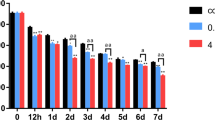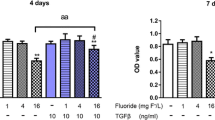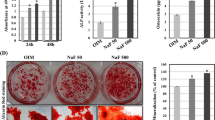Abstract
Thein vitro osteogenic effects of fluoride have not always been consistently observed in human bone cells. The present study sought to test if dexamethasone (Dex)_ could potentiate the action of fluoride to increase the detectability of the stimulatory effects of fluoride on [3H]thymidine incorporation, alkaline phosphatase (ALP) specific activity, collagen synthesis, and osteocalcin secretion in human TE85 osteosarcoma cells. Neither Dex at 10−10–10−6 M or fluoride at a mitogenic dose (100 μM) had any consistent stimulatory effects on thymidine incorporation. When the cells were treated with both agents simultaneously, significant and highly reproducible stimulations were observed. The mitogenic effects of the two agents were confirmed with cell number counting. Analysis of variance (ANOVA) revealed a significant interaction (P<0.001) between fluoride and Dex on cell proliferation. The enhancing effect of Dex on [3H]thymidine incorporation was not due to a shift of the optimal dose response of fluoride. Though fluoride alone or Dex alone also had no consistent effect on ALP specific activity, the co-treatment with fluoride and Dex for 24 hours produced significant (P<0.001, ANOVA) stimulation in ALP specific activity. Fluoride alone had no consistent effect on collagen synthesis and on 1,25(OH)2D3-dependent osteocalcin secretion, whereas Dex treatment consistently inhibited these two osteoblastic parameters in a dose-dependent manner. However, both the collagen synthesis and osteocalcin secretion rates were significantly higher (P<0.001 ANOVA for each) when the cells were co-treated with Dex and fluoride (100 μM) than when they were treated with Dex alone. Thus, these data indicate that the response in collagen synthesis and osteocalcin secretion to fluoride stimulation was more readily observed in the presence of Dex than in its absence. ANOVA analysis revealed that the interaction between fluoride and Dex on collagen synthesis, but not the 1,25(OH)2D3-dependent osteocalcin secretion, was significant (P<0.02). In summary, we have demonstrated for the first time that in TE85 cells (1) Dex potentiated the effects of fluoride on cell proliferation, ALP specific activity, and collagen synthesis; (2) while Dex at 10−7–10−6 M alone inhibited the collagen synthesis and at 10−9–10−6 M reduced osteocalcin secretion, Dex at 10−8–10−6 M significantly stimulated the proliferation of TE85 cells; and (3) Dex interacted with fluoride to increase the percentage of experiments showing an osteogenic action of fluoride. In conclusion, thein vitro osteogenic actions of fluoride in human TE85 cells are more consistently observed in the presence than in the absence of Dex.
Similar content being viewed by others
References
Riggs, BL, Seeman E, Hodgson JF, Taves DR, O'Fallon WM (1982) Effect of the fluoride/calcium regimen on vertebral fracture occurrence in postmenopausal osteoporosis. N Engl J Med 306:446–449
Briancon D, Meunier PJ (1981) Treatment of osteoporosis with fluoride, calcium, and vitamin D. In: Frost HM (ed) The orthopedic clinics of North America, vol 12, Saunders, Philadelphia, pp 629–648
Farley JR, Wergedal JR, Baylink DJ (1983) Fluoride directly stimulates proliferation and alkaline phosphatase activity of bone-forming cells. Science 222:330–332
Wergedal JE, Lau K-HW, Baylink DJ (1988) Fluoride and bovine bone extract influence cell proliferation and phosphatase activities in human bone cell cultures. Clin Orthop Rel Res 233:274–282
Lau K-HW, Yoo A, Wang SP (1991) Aluminum stimulates the proliferation and differentiation of osteoblasts in vitro by a mechanism that is different from fluoride. Mol Cell Biochem 105:93–105
Bellows CG, Aubin JE, Heersche JNM (1993) Differential effects of fluoride during initiation and progression of mineralization of osteoid nodules formed in vitro. J Bone Miner Res 8:1357–1363
Bellows CG, Heersche JNM, Aubin JE (1990) The effects of fluoride on osteoblast progenitors in vitro. J Bone Miner Res 5:S101-S105
Hall BK (1987) Sodium fluoride as an initiator of osteogenesis from embryonic mesenchyme in vitro. Bone 8:111–116
Reed BY, Zerwekh JE, Antich PP, Pak CYC (1993) Fluoride-stimulated [3H]thymidine uptake in a human osteoblastic osteosarcoma cell line is dependent on transforming growth factor β. J Bone Miner Res 8:19–25
Zerwekh JE, Morris AC, Padalino PK, Gottschalk F, Pak CYC (1990) Fluoride rapidly and transiently raises intracellular calcium in human osteoblasts. J Bone Miner Res 5:S131-S136
Modrowski D, Miravet L, Feuga M, Bannie F, Marie PJ (1992) Effect of fluoride on bone and bone cells in ovariectomized rats. J Bone Miner Res 7:961–969
Kassem M, Mosekilde L, Eriksen EF (1993) 1,25-Dihydroxyvitamin D3 potentiates fluoride-stimulated collagen type I production in cultures on human bone marrow stromal osteoblast-like cells. J Bone Miner Res 8:1453–1458
Kassem M, Mosekilde L, Eriksen EF (1994) Effects of fluoride on human bone cells in vitro: differences in responsiveness between stromal osteoblast precursors and mature osteoblasts. Acta Endocrinol 130:381–386
Khokher MA, Dandona P (1990) Fluoride stimulates3H-thymidine incorporation and alkaline phosphatase production by human osteoblasts. Metabolism 39:1118–1121
Kopp JB, Robey PG (1990) Sodium fluoride does not increase human bone cell proliferation or protein synthesis in vitro. Calcif Tissue Int 47:221–229
Chavassieux P, Chenu C, Valentin-Opran A, Delmas PD, Boivin G, Chapuy MC, Meunier PJ (1993) In vitro exposure to sodium fluoride does not modify activity or proliferation of human osteoblastic cells in primary cultures. J Bone Miner Res 8:37–44
Baylink DJ, Farley JR, Lau K-HW, Wergedal JE (1992) Letters to the editor. Sodium fluoride does not increase human bone cell proliferation or protein synthesis in vitro. Calcif Tissue Int 50:96–98
Lau K-HW, Tanimoto H, Baylink DJ (1988) Vanadate stimulates bone cell proliferation and bone collagen synthesis in vitro. Endocrinology 123:2858–2867
Mohan S, Baylink DJ (1991) Bone growth factors. A review. Clin Orthop Rel Res 263:30–48
Farley JR, Tarbaux N, Hall S, Baylink DJ (1988) Evidence that fluoride-stimulated [3H]thymidine incorporation in embryonic chick calvarial cell cultures is dependent on the presence of a bone cell mitogen, sensitive to changes in the phosphate concentration, and modulated by systemic skeletal effectors. Metabolism 37:988–995
Takada J, Baylink DJ, Lau K-HW (1995) Pretreatment with low doses of norethindrone potentiates the osteogenic effects of fluoride on human osteosarcoma cells. J Bone Miner Res 10:1512–1522
Ron D, Brasier AR, Wright KA, Habener JF (1990) The permissive role of glucocorticoids on interleukin-1 stimulation of angiotensinogen gene transcription is mediated by an interaction between inducible enhancers. Mol Cell Biol 10:4389–4395
Munck A, Naray-Fejes-Toth A (1992) The ups and downs of glucocorticoid physiology. Permissive and suppressive effects revisited. Mol Cell Endocrinol 90:C1–4
Hadcock JR, Malbon CC (1988) Regulation of beta-adrenergic receptors by “permissive” hormones: glucocorticoids increase steady-state levels of receptor mRNA. Proc Natl Acad Sci USA 85:8415–8419
Rhim JS, Cho HY, Huebner RJ (1975) Non-producer human cells induced by murine sarcoma virus. Int J Cancer 15:23–29
Lau K-HW, Lee MY, Linkhart TA, Mohan S, Vermeiden J, Liu CC, Baylink DJ (1985) A mouse tumor-derived osteolytic factor stimulates bone resorption by a mechanism involving local prostaglandins production in bone. Biochim Biophys Acta 840:56–68
Farley JR, Jorch UM (1983) Differential effects of phospholipids on skeletal alkaline phosphatase activity in extracts, in situ, and in circulation. Arch Biochem Biophys 221:477–488
Lowry OH, Rosebrough NJ, Farr AL, Randall RJ (1951) Protein measurement with the Folin Phenol reagent. J Biol Chem 193:265–275
Beresford JN, Gallagher JA, Russell RGG (1986) 1,25-Dihydroxyvitamin D3 and human bone-derived cells in vitro: effects on alkaline phosphatase, type I collagen and proliferation. Endocrinology 119:1776–1785
Taylor AK, Linkhart SG, Mohan S, Baylink DJ (1988) Development of a new radioimmunoassay for human osteocalcin: evidence for a midmolecule epitope. Metabolism 37:872–877
Farley JR, Baylink DJ (1986) Skeletal alkaline phosphatase activity as a bone formation index in vitro. Metabolism 35: 563–571
Lau K-HW, Wang SP, Linkhart TA, Demarest KT, Baylink DJ (1994) Picomolar norethindrone in vitro stimulates the cell proliferation and activity of a human osteosarcoma cell line and increases bone collagen synthesis without an effect on bone resorption. J Bone Miner Res 9:695–703
Silve C, Fritsch J, Grosse B, Tau C, Edelman A, Delmas P, Balsan S, Garabedian M (1989) Corticosteroid-induced changes in the responsiveness of human osteoblast-like cells to parathyroid hormone. Bone Miner 6:65–75
Leboy PS, Beresford JN, Devlin C, Owen ME (1991) Dexamethasone induction of osteoblast mRNAs in rat marrow stromal cell cultures. J Cell Physiol 146:370–378
Morrison NA, Shine J, Fragonas J-C, Verkest V, McMenemy ML, Eisman JA (1989) 1,25-Dihydroxyvitamin D-responsive element and glucocorticoid repression in the osteocalcin gene. Science 246:1158–1161
Oursler MJ, Riggs BL, Spelsberg TC (1993) Glucocorticoid-induced activation of latent transforming growth factor-β by normal human osteoblast-like cells. Endocrinology 133:2187–2196
Rowley DR (1992) Glucocorticoid regulation of transforming growth factor-β activation in urogenital sinus mesenchymal cells. Endocrinology 131:471–478
Hahn TJ (1978) Corticosteroid-induced osteopenia. Arch Intern Med 138:882–888
Baylink DJ (1983) Glucocorticoid-induced osteoporosis. N Engl J Med 309:306–308
Libanati CR, Baylink DJ (1992) Prevention and treatment of glucocorticoid-induced osteoporosis. A pathogenetic perspective. Chest 102:1426–1435
Okazaki R, Rigg BL, Conover CA (1994) Glucocorticoid regulation of insulin-like growth factor-binding protein expression in normal human osteoblast-like cells. Endocrinology 134:126–132
Chyun YS, Kream BE, Raisz LG (1984) Cortisol decreases bone formation by inhibiting periosteal cell proliferation. Endocrinology 114:477–480
Hughes-Fulford M, Appel R, Kumegawa M, Schmidt J (1992) Effect of dexamethasone on proliferating osteoblasts: inhibition of prostaglandin E2 synthesis, DNA synthesis, and alterations in actin cytoskeleton. Exp Cell Res 203:150–156
McCulloch CAG, Tenenbaum HC (1986) Dexamethasone induces proliferation and terminal differentiation of osteogenic cells in tissue culture. Anat Rec 215:397–402
Odvina CV, Wergedal JE, Baylink DJ (1986) Glucocorticoid-induced osteoporosis. In: Uthoff HR, Jaworski ZFG (eds) Current concepts of bone fragility. Springer-Verlag, Berlin pp 295–309
Author information
Authors and Affiliations
Rights and permissions
About this article
Cite this article
Takada, J., Chevalley, T., Baylink, D.J. et al. Dexamethasone enhances the osteogenic effects of fluoride in human TE85 osteosarcoma cellsin vitro . Calcif Tissue Int 58, 355–361 (1996). https://doi.org/10.1007/BF02509385
Received:
Accepted:
Issue Date:
DOI: https://doi.org/10.1007/BF02509385




